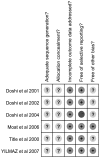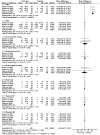Efficacy of folic acid supplementation on endothelial function and plasma homocysteine concentration in coronary artery disease: A meta-analysis of randomized controlled trials
- PMID: 24940394
- PMCID: PMC3991512
- DOI: 10.3892/etm.2014.1553
Efficacy of folic acid supplementation on endothelial function and plasma homocysteine concentration in coronary artery disease: A meta-analysis of randomized controlled trials
Abstract
The aim of the present study was to conduct an updated meta-analysis of relevant randomized controlled trials (RCTs) in order to estimate the effect of folic acid supplementation on endothelial function and the concentration of plasma homocysteine in patients with coronary artery disease (CAD). An extensive search of PubMed was conducted to identify RCTs that compared folic acid with placebo therapy. The mean difference (MD) and 95% confidence interval (CI) were used as a measure of the correlation between folic acid supplementation and endothelial function/plasma homocysteine concentration. Of the 377 patients included in this analysis, 191 patients underwent folic acid supplementation and 186 individuals underwent placebo treatment. Compared with the use of a placebo, folic acid supplementation alone exhibited significant efficacy on increasing flow-mediated dilation (FMD; MD, 57.72 μm; 95% CI, 50.14-65.31; P<0.05) and lowering the concentration of plasma homocysteine (MD, -3.66 μmol/l; 95% CI, -5.44--1.87; P<0.05; I2, 87%). There was no significant change in the response to end diastolic diameter, glyceryl-trinitrate diameter, heart rate, baseline and peak hyperemic flow and systolic and diastolic blood pressure between the folic acid and placebo groups (P>0.05). Therefore, the meta-analysis indicated that 5 mg folic acid daily supplementation for >4 weeks significantly improved FMD and lowered the concentration of plasma homocysteine in patients with CAD. However, more RCTs are required in order to confirm these observations.
Keywords: coronary artery disease; endothelial function; folic acid; homocysteine; meta-analysis.
Figures






References
-
- Quyyumi AA. Prognostic value of endothelial function. Am J Cardiol. 2003;91:19H–24H. - PubMed
-
- Weber T, Auer J, O’Rourke MF, et al. Arterial stiffness, wave reflections, and the risk of coronary artery disease. Circulation. 2004;109:184–189. - PubMed
-
- Vinukonda G, Shaik Mohammad N, Md Nurul Jain J, Prasad Chintakindi K, Rama Devi Akella R. Genetic and environmental influences on total plasma homocysteine and coronary artery disease (CAD) risk among South Indians. Clin Chim Acta. 2009;405:127–131. - PubMed
-
- Lin PT, Huang MC, Lee BJ, Cheng CH, Tsai TP, Huang YC. High plasma homocysteine is associated with the risk of coronary artery disease independent of methylenetetrahydrofolate reductase 677C-->T genotypes. Asia Pac J Clin Nutr. 2008;17:330–338. - PubMed
LinkOut - more resources
Full Text Sources
Other Literature Sources
Miscellaneous
